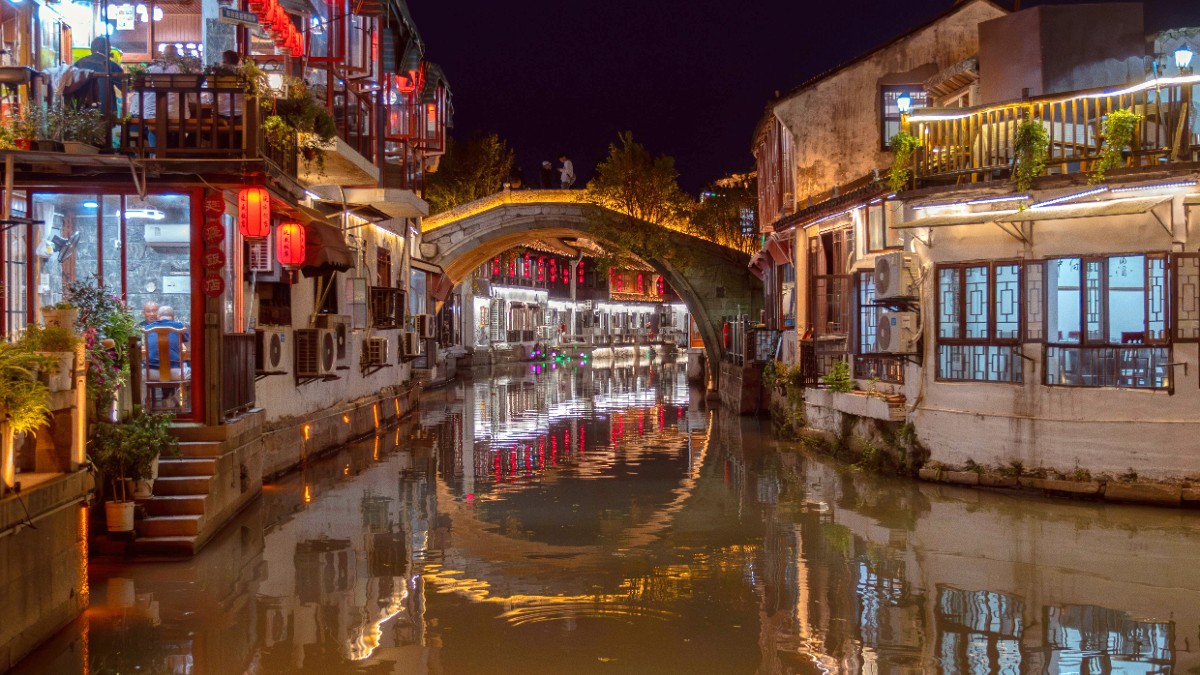
Jiangsu, China
The city's extensive network of canals, stone bridges, and traditional architecture form a picturesque landscape. These waterways, once for trade and transport, now present scenic routes for leisurely boat tours. They link visitors to the city's past. Alongside this historical charm, Suzhou embraces modernity. High-tech industries and contemporary architecture, especially in areas like the Suzhou Industrial Park, mark the city's forward-thinking approach.
Suzhou maintains its cultural identity with pride. Kunqu Opera, one of China's oldest operatic forms, originated here. The city's silk industry, which thrived for centuries, continues to produce high-quality silk products.
These elements combine to present a travel experience appealing to varied interests. History enthusiasts find depth in its ancient sites. Art lovers appreciate its gardens and traditional crafts. Those desiring relaxation find peace by its canals.
Suzhou occupies a strategic position in the southeastern part of Jiangsu Province, China. It sits within the central Yangtze River Delta, a region known for its economic dynamism and cultural richness. Suzhou borders the city of Wuxi to its west, connecting it further into Jiangsu's network. To the south, it shares borders with Huzhou and Jiaxing, both cities in Zhejiang Province. This southern connection links Suzhou to another province with deep historical roots.
East of Suzhou, travelers find Shanghai, approximately 100 kilometers (62 miles) away. This proximity makes Suzhou a popular day trip or a convenient next stop for visitors arriving in Shanghai. The journey between the two cities proceeds quickly and efficiently. North of Suzhou, across the vast Yangtze River, lies Nantong. The river itself acts as a natural boundary and a historic artery of trade and transport.
Suzhou is within this economically dynamic and culturally rich region.
Its location on the lower reaches of the Yangtze River and Lake Taihu brings abundant water.
Numerous canals, rivers, and lakes define Suzhou's landscape and development.
High-speed trains or buses from Shanghai airports make Suzhou easily reachable.
Surrounding flat, fertile lands support agriculture, including rice and tea.
The city's location on the lower reaches of the Yangtze River and along the shores of Lake Taihu blesses it with abundant water resources. This watery landscape defines Suzhou. Numerous canals, rivers, and lakes crisscross the urban area and its surrounding regions. This extensive waterway system gained Suzhou its famous nickname, "Venice of the East." The canals are not merely scenic; they shaped the city's development, commerce, and daily life for centuries.
Travelers arriving from major international hubs often fly into Shanghai's airports, then board high-speed trains or buses directly to Suzhou. The close distance and efficient transport links render Suzhou easily accessible. This geographical placement allows a visitor to combine a trip to Suzhou with explorations of other major cities in the Yangtze River Delta, forming a comprehensive regional itinerary.
The flat, fertile plains surrounding Suzhou sustain agriculture, especially rice and tea cultivation. The region's abundant water also means a rich supply of freshwater fish and seafood, influencing local cuisine.
Suzhou's origins trace back to 514 BC when King Helü of the Wu Kingdom founded it as his capital. This early foundation created the beginning for Suzhou's long and celebrated existence.
Suzhou's history spans over 2,500 years, establishing it as one of China's oldest cities. For centuries, Suzhou grew as a hub for various important activities. It became known for silk production, an industry that brought immense wealth and fame. Its strategic location, especially on the Grand Canal, confirmed its role as a commercial center. The Grand Canal, a colossal ancient waterway, joined the northern and southern parts of China, facilitating trade and cultural exchange.
During the Ming (1368–1644) and Qing (1644–1912) dynasties, Suzhou reached its peak of prosperity and cultural influence. Wealthy merchants and retired officials commissioned the creation of elaborate classical gardens within the city. These gardens, designed as private retreats, represent the pinnacle of Chinese landscape architecture.
Many gardens hold on today, meticulously preserved, holding UNESCO World Heritage status. They reflect a philosophical approach to nature and art, crafting miniature landscapes that evoke larger natural scenes.
Suzhou's cultural impact extended beyond gardens. It became a renowned center for scholars, artists, and artisans, fostering influential painters, calligraphers, and Kunqu Opera performers.
Suzhou embroidery, one of China's four famous embroidery styles, also flourished here, recognized for its intricate detail and lifelike portrayal.
Despite periods of turmoil, Suzhou consistently rebuilt and retained its cultural identity. Its historical core, notably around areas like Pingjiang Road and Shantang Street, presents a tangible link to this past.
Suzhou is a major economic hub and a popular tourist destination in China. The city successfully balances its rich historical legacy with rapid modern development. This duality defines Suzhou's character today.
Its fame rests on several defining features. The classical gardens, with their serene beauty and intricate design, draw visitors from around the globe. The city's intricate canals, often navigated by traditional boats, present a picturesque way to experience its charm.
Economically, Suzhou forms a part of the Yangtze River Delta economic zone. It has grown into a hub for high-tech industries, attracting investment and talent. This economic vibrancy fuels the city's modern infrastructure and amenities.
Wander through ancient gardens and historic streets.
Discover traditional arts like silk embroidery and Kunqu Opera.
Enjoy boat rides along the canals.